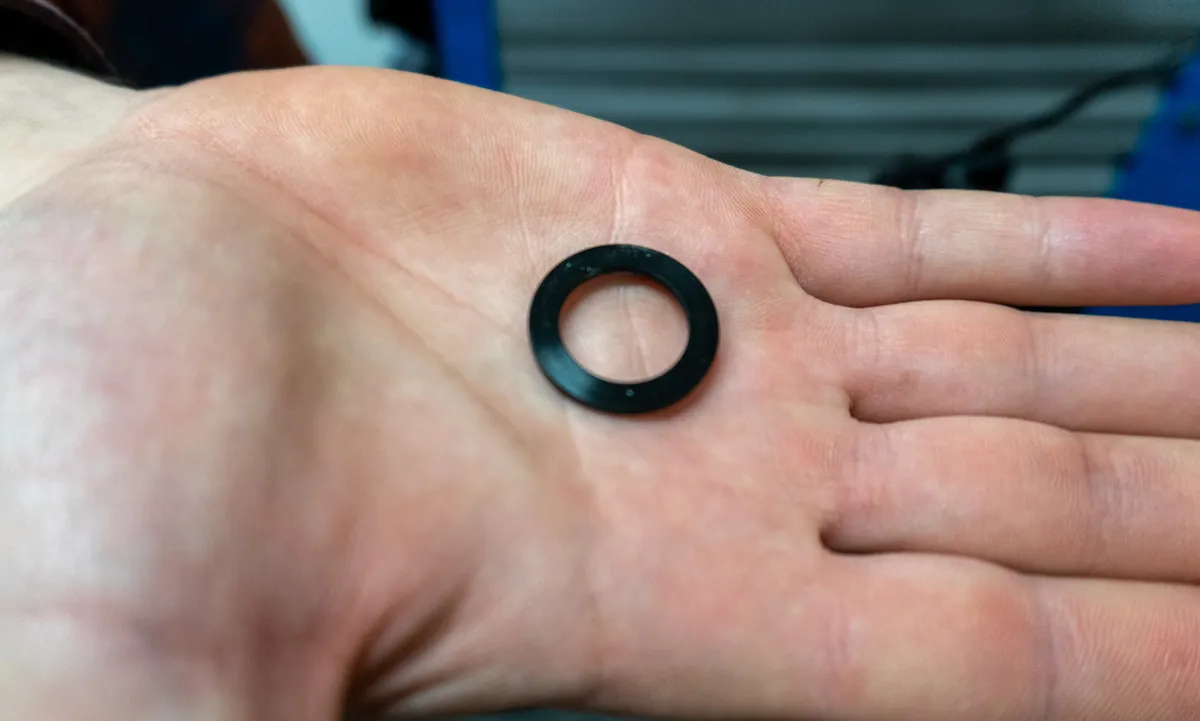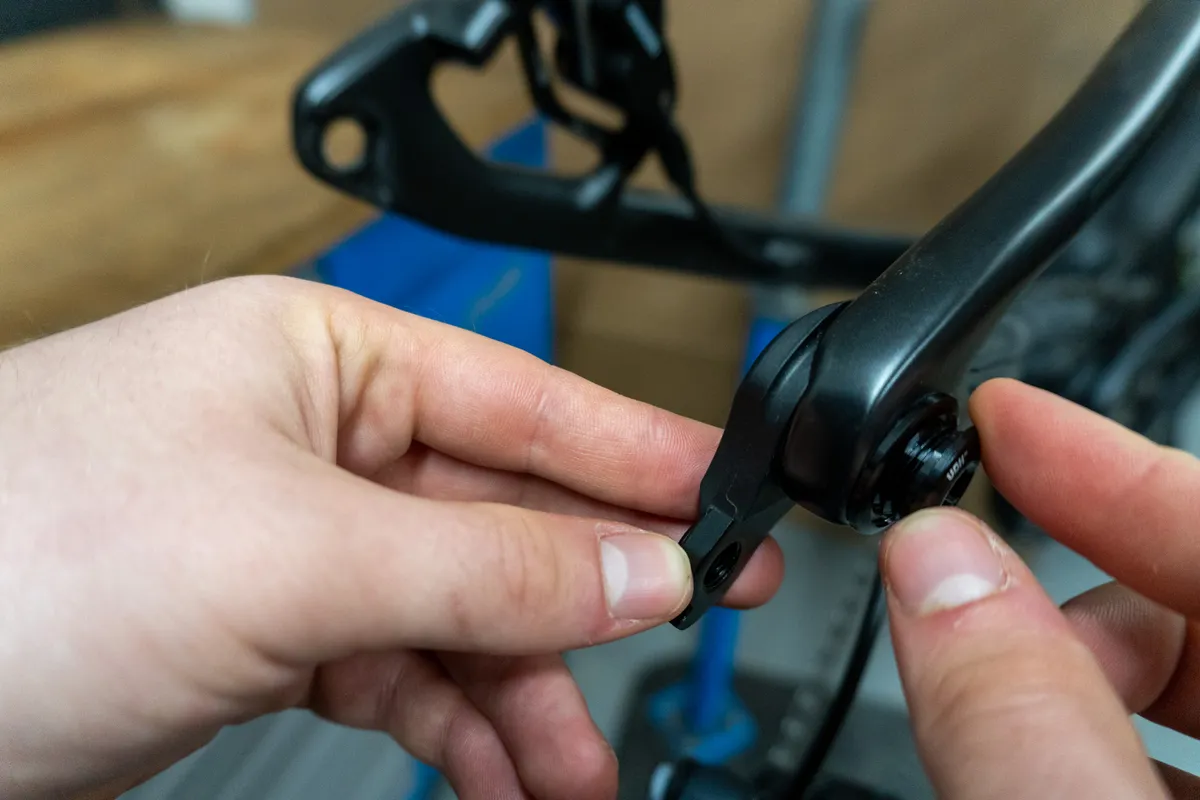The derailleur hanger is a sacrificial part that connects the rear derailleur to the dropout. In the event of an impact, the derailleur hanger is designed to bend or break, protecting your rear derailleur and frame.
For many years, derailleur hangers were frame-specific. If you broke one, it would often mean a trip to the bike shop, where the workshop would rummage through drawers of hangers to find a replacement – or they would have to order one in.
That changed when SRAM launched its Universal Derailleur Hanger (UDH) standard in 2019.
In this guide, we’ll take you through what exactly SRAM UDH is, how it works, bike compatibility and how to remove and install the hanger.
We’ll also explain how it differs from Shimano’s direct-mount standard and SRAM’s latest T-Type Eagle Transmission drivetrains.
What is SRAM UDH?

SRAM UDH is designed to unify derailleur hanger standards.
SRAM says consolidating different hanger designs makes replacing a bent hanger easier and helps optimise shifting because there are fewer variables.
Like many other hangers, the UDH is made of two parts – the hanger itself and what SRAM refers to as the ‘UDH bolt’, which secures the hanger to the dropout.
On some frames, you’ll need to use a ‘UDH frame washer’ between the hanger and bolt. It’s worth consulting your frame manufacturer to check if it’s required, although it’s generally used on split-pivot designs from brands such as Devinci, Orbea, Salsa and Trek.

You’ll also need to make sure you use a compatible thru-axle to secure the rear wheel. SRAM specifies thru-axles must use a M12x1.0 thread pitch and a thread length of 12.7mm.
SRAM has made the UDH’s design an open-standard. After-market brands such as Wheels Manufacturing offer anodised options, with different colour options to match to your bike.
You’re also not limited to using only SRAM rear derailleurs. The UDH is compatible with other mountain bike groupset manufacturers, such as Shimano.
Many brands have adopted the standard on their mountain bikes since UDH was announced. It’s much easier knowing a hanger will almost certainly be readily available at most bike shops, rather than having to trawl through the internet and find your specific derailleur hanger.

SRAM UDH is also beginning to find traction on some gravel bikes, such as the Berria Belador Allroad, ENVE MOG and the Scott Solace. However, it hasn’t fully caught on yet and it’s seldom seen on road bikes.
What happens to SRAM UDH if your chain jams?

Rather than simply break or bend, SRAM has designed the hanger to pivot backwards in the event of the chain jamming. It can also slip slightly rearwards to help absorb an impact if the hanger is knocked.
If the hanger pivots backwards, it can be pushed back forward, often without needing to loosen the thru-axle.
It also sports a hooked lip to push the chain back onto the smallest cassette cog if it slips off. This prevents the chain from jamming between the dropout and cassette.
SRAM UDH compatibility: which bikes use SRAM UDH?

Only bikes that are designed around SRAM UDH will work with the standard.
Unlike other standards in the cycling industry, such as bottom brackets or headsets, the adoption of SRAM’s UDH standard among brands was rapid. The standard was announced in 2019 and many performance mountain bikes now use it, such as the Trek Fuel EX, Scott Scale RC and Canyon Neuron.
SRAM has a bike finder on its website so you can check if your bike uses the standard.
How to install or replace a SRAM UDH on your bike
Step 1

Shift the chain into the smallest cog. If your rear derailleur features a clutch mechanism, switch it off.
Step 2

Remove the rear derailleur.
Step 3

Remove the rear wheel thru-axle.
Step 4

Loosen the UDH mounting bolt on the outside face of the driveside dropout. Note the bolt is reverse-threaded.
Step 5

Remove the UDH from the inside face of the driveside dropout.
Step 6

Clean the dropout thoroughly with a rag and isopropyl alcohol.
Step 7

Seat the UDH in the frame. Rotate it forward completely until the stop contacts the frame.
Step 8

Install the bolt. If your frame requires a washer between the hanger and bolt, make sure you install it before installing the bolt. Note SRAM says specifically not to apply any preparation to the threads of the bolt.
Step 9

Because the UDH bolt is reverse-threaded, tighten it in anti-clockwise orientation. Using a torque wrench, tighten the bolt to 25Nm, making sure it’s seated properly in the frame.
Step 10

Reinstall the wheel and rear derailleur.
SRAM UDH vs Shimano direct-mount

SRAM was not the first brand to try to unify derailleur hanger standards.
Shimano introduced its direct-mount standard in 2012 when it released its Shadow-style mountain bike rear derailleurs. This eventually ported over to the road when the brand released Dura-Ace R9100 and gravel with GRX.
The direct-mount was designed to create a stronger connection between the frame and rear derailleur to improve shifting quality. Shimano also claimed it sped up wheel changes.
Shimano included a ‘B-link’ to connect the rear derailleur to a conventional hanger because the Shadow derailleurs are positioned further to the rear.
A direct-mount hanger sees the B-link removed and the rear derailleur bolted straight onto the hanger.
Though a number of aftermarket products are available to fit a variety of bikes, the standard has never really gained traction.
Shimano appears to be developing a universal derailleur hanger similar to SRAM T-Type, according to a patent application filed in 2022. The patent shows a hanger that slots on either side of the dropout and is held in place by the axle.
SRAM UDH and SRAM T-Type

In March 2023, SRAM launched its T-Type Eagle Transmission mountain bike drivetrains.
Eagle Transmission does away with a derailleur hanger altogether, mounting the derailleur hanger directly to the frame.

While SRAM UDH isn't needed for these new, hanger-free drivetrains, it did lay the groundwork for them.
That's because Eagle Transmission drivetrains are only compatible with bikes designed around the SRAM UDH standard.
As well as ditching derailleur hangers, the Eagle Transmission drivetrains do away with limit screws and B-gap adjustment on the rear derailleur.
